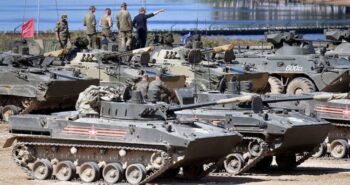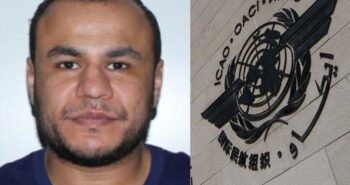The Rise of Haftar’s Forces
By Wolfram Lacher
 This paper analyses Haftar’s rise and the concomitant transformation of his forces. The prevailing view sees the LAAF as a “core of regulars, many from the Qadhafi era, surrounded by an informal coalition of militias”.
This paper analyses Haftar’s rise and the concomitant transformation of his forces. The prevailing view sees the LAAF as a “core of regulars, many from the Qadhafi era, surrounded by an informal coalition of militias”.
.
PART SEVEN
From 2018 onwards, the GNA budget also included an additional 4bn Dinars worth of salaries for new employees of the eastern government.
Tripoli continued to pay members of Haftar’s forces who had been on the payrolls before the mid-2014 split; across the country, Haftar incentivized even nominal adherence to his forces by paying an additional salary on top of what soldiers received from Tripoli.
An attempt to take a more forceful approach in southern Libya proved unsuccessful.
In February 2018, Haftar tried to expand in the southern city of Sabha by extending the LAAF franchise to armed groups from the Awlad Suleiman – such as Massoud Jiddi’s militia, which became the LAAF’s 116th Battalion. But the largest Awlad Suleiman militia, the 6th Brigade, split over its alignment with Haftar. Moreover, given that these groups had fought against the Tubu in preceding intercommunal conflicts, Haftar’s strategy alienated large parts of the Tubu community in Sabha.
In May 2018, Tubu armed groups wrested the fortress that overlooked the city from the LAAF-aligned 6th Brigade. The Sabha failure of 2018 seemed to show that Haftar advanced so cautiously not only because he sought to appear as a stabilizing force, rather than an aggressor.
It suggested that he also lacked the necessary manpower to pursue a more forceful strategy. Many of his original allies in Benghazi were reluctant to venture beyond the east. But over 2017 and 2018, the growth of units led by his sons and relatives or their close associates gradually strengthened Haftar’s room for manoeuvre.
The battle of Darna, which began in May 2018 and dragged on until February 2019, offered a showcase for these new units: (a) The 106th and Tareq ben Ziyad Battalions; (b) the 155th and 166th Battalions headed by Haftar’s cousin Basem al-Buaishi and his nephew Ayub Busaif; (c) the Salafist-leaning 210th and 302nd Battalions; and (d) Al-Zadma’s 128th Battalion, as well as a small group led by longtime Haftar loyalist Ali al-Qataani, who would go on to head another large unit, the 73rd Brigade.
As Benghazi, the Darna conflict was far from the clear-cut counter-terrorist operation as which Haftar portrayed it, and for which he gained French intelligence support. Haftar had long punished Darna as a whole by imposing a crippling siege on the city, at times preventing all food and medicine from reaching the city for several months.
As in Benghazi, Haftar’s adversaries were a mixture of revolutionaries, hardened jihadists, and men who sought to protect their families and possessions against Haftar’s groups; As in Benghazi, Haftar also mobilized local armed groups from Darna’s surroundings who looted and confiscated properties.
And as in Benghazi, the new, loyal units moved against some of the local armed groups Haftar had mobilized for the war. When the battle of Darna drew to a close in early 2019, Haftar was able to send these new units first southwards, then westwards.
The Ponzi Scheme
In January 2019, Haftar tasked a force of some 350 vehicles with the declared aim of “liberating the south from terrorists and Chadian gangs”.
The core units involved were the Tareq ben Ziyad and 128th Battalions, whose commanders both had close ties to Haftar’s sons, were themselves from southern Libyan tribes, and employed a substantial number of Sudanese mercenaries as auxiliaries.
They encountered little resistance. Across the south, anger had been on the rise for months due to rampant insecurity, the collapse of public services, and the disinterest of the government in Tripoli for the region’s predicament.
Many hoped Haftar’s takeover would bring improvement. The force was too small to take southern Libya through a military offensive. Instead, using promises of cash and the expectation that he would soon rule in Tripoli, Haftar enticed southern armed groups into declaring their loyalty to him.
In Sabha, most armed groups from the Awlad Suleiman did exactly that, helped by the fact that a fellow tribesman, Hassan al-Zadma, led the 128th Battalion.
Those that failed to align with Haftar kept their weapons, but lay low. Tubu armed groups in Sabha negotiated the handover of their bases, then withdrew towards Murzuq. Tuareg armed groups in Ubari also adhered to Haftar’s forces, allowing Haftar to take control of the key oilfield of al-Sharara.
GNA-aligned armed groups tried to turn matters around by appointing the senior Tuareg officer Ali Kanna as the GNA commander for the southern region, but this backfired.
In a situation where Haftar promised to bring some long-yearned-for stability, the GNA appeared as a spoiler. Local opinion was overwhelmingly in favour of allowing Haftar to take over, to prevent a rift through the local community.
Resistance to Haftar’s southern expansion was limited to parts of the Tubu community. The prominent role of Zadma made it obvious that Haftar aligned with the Awlad Suleiman against the Tubu in Sabha.
Moreover, the accompanying rhetoric about “Chadian gangs” had already served as code language for Tubu armed groups in previous Sabha conflicts. When Haftar’s forces moved southwards towards Murzuq, local Tubu forces violently opposed them.
But that opposition soon faltered, and even violent reprisals by Haftar’s forces against the Tubu community in Murzuq did not provoke wider resistance. The Tubu had no allies to support them against Haftar, whether in the south or in the GNA.
Public opinion in western Libya had become used to seeing Tubu forces as foreign invaders, and was supportive of the operation. Even GNA Interior Minister Fathi Bashagha declared his approval.
Moreover, Haftar retained some staunch Tubu loyalists – including a recently established armed group with a pronounced Salafist tendency, the Khaled ben al-Walid Battalion in Umm al-Araneb.
In other towns with a sizeable Tubu population, such as al-Qatrun, local armed groups therefore recognized Haftar’s authority while otherwise staying put – much like what had happened before in Sabha and Ubari.
Haftar’s southern campaign did not translate into meaningful territorial control. After an initial groundswell of support as the eastern government supplied goods and cash to southern cities, it became clear that the region’s predicament remained the same. Armed groups, including foreign mercenaries, largely remained in the same positions.
But in the meantime, Haftar’s successful and largely bloodless southern expansion had fundamentally altered the calculations of both local and international actors. The expectation that Haftar’s takeover of power in Tripoli was inevitable became increasingly widespread.
Western diplomats and UN Special Representative Ghassan Salamé now made another attempt at striking a deal between Haftar and the GNA, to give Haftar the dominant role he now appeared to deserve.
It remains unclear whether they genuinely believed that Haftar was ready for a compromise, as they claimed. They did, however, warn politicians in western Libya that Haftar was ready to use force if negotiations proved unsuccessful.
In late February 2019, Haftar and Serraj met in Abu Dhabi and appeared to agree on the outlines of such a deal. But in the following weeks, both backtracked.
Because Haftar’s further progress appeared increasingly inevitable, politicians and militia leaders from western Libya covertly intensified their contacts with Haftar.
Haftar gained promises from a number of actors in Tripoli, Zawiya, Gharyan, Tarhuna and Misrata that they would side with his forces, or at least not oppose them.
In exchange, these actors were hoping to safeguard their local fiefdoms, or feature in a new political dispensation dominated by Haftar.
But whether these actors would honour any commitments they had made to Haftar remained unclear as long as he made no progress towards Tripoli.
In February and March 2019, then, Haftar’s alliance increasingly began to resemble a Ponzi scheme built on the expectation that Haftar would seize power.
This expectation led actors in southern Libya to refrain from contesting Haftar’s fragile hold over the region, and actors in western Libya to prepare for his advance towards Tripoli.
But in order to prevent the scheme from unravelling, Haftar had to make continued progress on the ground.
It is likely that Haftar could have expanded further by establishing more footholds in western Libya while maintaining ambivalence towards forces that eyed his impending arrival with suspicion or hostility.
Instead, on 3 April 2019, he launched a large-scale offensive on Tripoli, forcing actors in western Libya to immediately and unambiguously take sides.
The Machine Gets Stuck in Tripoli
Both Haftar himself and many foreign observers overestimated the willingness of western Libyan forces to accept his takeover by force. Two western Libyan armed groups did indeed switch sides and allowed Haftar to establish two crucial forward bases for his Tripoli operation: a militia led by Adel Da’ab in Gharyan, and the militia of the Kani brothers in Tarhuna – the Kaniyat.
In both cases, the calculations were clearly opportunistic. Da’ab had fought against Haftar’s Zintani allies in 2014-15, and by 2019, he was at loggerheads with the Zintani commander of the western military region, Osama Juwaili. In February 2019, Da’ab’s militia became the 111 th Battalion of LAAF Brigade 106. 159 The Kaniyat had allied with Misratan armed groups in their attempt to gain a foothold in Tripoli, in August 2018.
In a second round of clashes in January 2019, their Misratan allies had abandoned the Kani brothers, causing them to look to Haftar for support. Western Libyan armed groups that had long been overtly or covertly affiliated with Haftar predictably joined his operation, among them militias from Zintan, Rujban, Sabratha and Surman – most of them dominated by Madkhali Salafists.
But the reactions of other armed groups confounded Haftar’s expectations. Zawiyan forces on 5 April captured over a hundred of Haftar’s troops who had apparently counted on cooperation from Zawiya to reach Tripoli. In the neighbouring Tripoli suburb of Janzur, the militia leader Naji Gneidi appeared to be in on the plan, but his fighters turned against him, causing him to flee that same night.
Misratan forces immediately began to mobilize to stop Haftar’s offensive, proving that Haftar had relied on promises from local actors with limited influence. The Tripoli militias that were widely suspected of being opportunistic enough to collude with Haftar were among the first to mobilize against him.
It was not simply that most of western Libya’s standing militias united against the common threat that Haftar’s forces posed to them. Haftar’s offensive also caused forces to mobilize that had remained dormant for years: people in revolutionary strongholds like Misrata and the Amazigh towns who had either fought themselves in 2011 or had relatives who did, but who had mostly remained on the sidelines of the post-revolutionary power struggles.
These forces were deeply embedded in local communities and highly cohesive, which helped explain the fierce resistance they offered to Haftar’s forces despite receiving little or nothing in the way of supplies and salaries from the Tripoli government. Foreign observers often underestimated the motivation of these forces. After the first three days of the conflict, virtually no defections occurred for the remainder of the war in western Libya.
Even months into the war, foreign diplomats kept waiting for them to switch sides and allow Haftar to make crucial advances. It never happened. The one notable exception proved the rule: In Sirte, the Salafist-leaning 604 th Battalion flipped in January 2020, allowing Haftar to capture the city without a fight. But Sirte, held by Misratan forces who had been widely unpopular in the city, was a former regime stronghold at the margins of western Libya, and the 604th Battalion was heavily recruited from the Firjan – Haftar’s tribe.
Elsewhere, side-switching made little sense even for more opportunistically-minded groups. After all, Haftar could give his enemies no credible assurances that he would not move against them once he had won the war. The threat of atrocities in the event of surrender also played a role. In Benghazi and Darna, the LAAF had been responsible for war crimes that were unparalleled in Libya’s post-2011 conflicts.
***
Wolfram Lacher is a Senior Associate in the Middle East and Africa Division at SWP.
___________

Stiftung Wissenschaft und Politik German Institute for International and Security Affairs.




